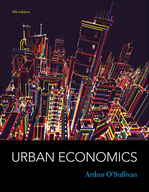Solution Found!
Rural versus Urban Development In the initial equilibrium, a nation’s workforce of 24 million is divided equally between a city and a rural area. The initial common utility level is $50. The urban utility curve has the conventional hump shape, with a peak at 8 million workers. In the workforce range 8–12 million, the slope of the utility curve is –$2 per million workers. The rural utility curve is subject to mild increasing returns to scale. In the workforce range 12–16 million, the slope is $1 per million workers. Suppose the nation invests in rural infrastructure, increasing rural productivity and shifting the rural utility curve upward by $3. a. Depict graphically the effects of this infrastructure investment on the two sectors. b. Workers will migrate from _____ to _____ because. . . . c. Migration [increases, decreases] utility in the rural area and [increases, decreases] utility in the city, with a [larger, smaller] change in the [city, rural area]. d. Show the new equilibrium distribution of the workforce between the rural area and the city. In the new equilibrium, the workforce of the city is _____ ; the workforce of the rural area is _____ ; the common utility level is _____ .
Chapter 4, Problem 6(choose chapter or problem)
Rural versus Urban Development
In the initial equilibrium, a nation’s workforce of 24 million is divided equally between a city and a rural area. The initial common utility level is $50. The urban utility curve has the conventional hump shape, with a peak at 8 million workers. In the workforce range 8–12 million, the slope of the utility curve is –$2 per million workers. The rural utility curve is subject to mild increasing returns to scale. In the workforce range 12–16 million, the slope is $1 per million workers. Suppose the nation invests in rural infrastructure, increasing rural productivity and shifting the rural utility curve upward by $3.
a. Depict graphically the effects of this infrastructure investment on the two sectors.
b. Workers will migrate from _____ to _____ because. . . .
c. Migration [increases, decreases] utility in the rural area and [increases, decreases] utility in the city, with a [larger, smaller] change in the [city, rural area].
d. Show the new equilibrium distribution of the workforce between the rural area and the city. In the new equilibrium, the workforce of the city is _____ ; the workforce of the rural area is _____ ; the common utility level is _____ .
Questions & Answers
QUESTION:
Rural versus Urban Development
In the initial equilibrium, a nation’s workforce of 24 million is divided equally between a city and a rural area. The initial common utility level is $50. The urban utility curve has the conventional hump shape, with a peak at 8 million workers. In the workforce range 8–12 million, the slope of the utility curve is –$2 per million workers. The rural utility curve is subject to mild increasing returns to scale. In the workforce range 12–16 million, the slope is $1 per million workers. Suppose the nation invests in rural infrastructure, increasing rural productivity and shifting the rural utility curve upward by $3.
a. Depict graphically the effects of this infrastructure investment on the two sectors.
b. Workers will migrate from _____ to _____ because. . . .
c. Migration [increases, decreases] utility in the rural area and [increases, decreases] utility in the city, with a [larger, smaller] change in the [city, rural area].
d. Show the new equilibrium distribution of the workforce between the rural area and the city. In the new equilibrium, the workforce of the city is _____ ; the workforce of the rural area is _____ ; the common utility level is _____ .
ANSWER:Step 1 of 5
Given data:
In the initial equilibrium, a nation's workforce of 24 million is divided equally between a city and a rural area. The initial common utility level is $50. The urban utility curve has the conventional hump shape, peaking at 8 million workers. In the workforce range of 8–12 million, the slope of the utility curve is –$2 per million workers. The rural utility curve is subject to mildly increasing returns to scale. In the 12–16 million workforce range, the slope is $1 per million workers. Suppose the nation invests in rural infrastructure, increasing productivity and shifting the rural utility curve by $3.
